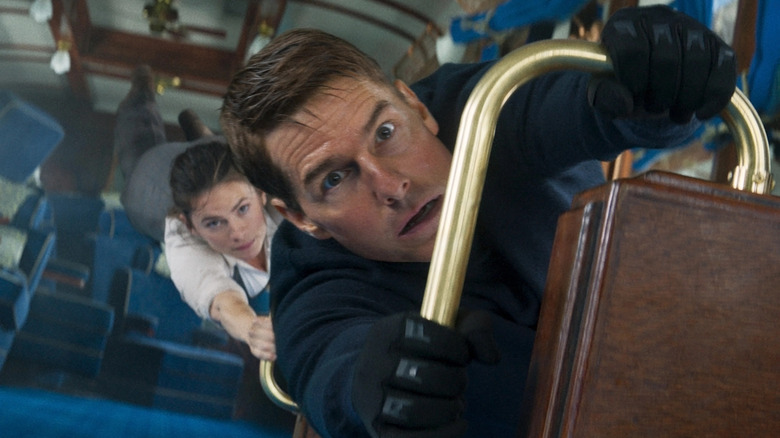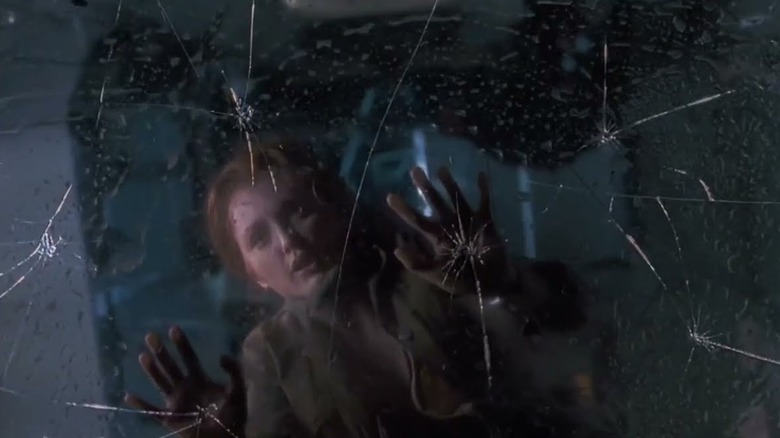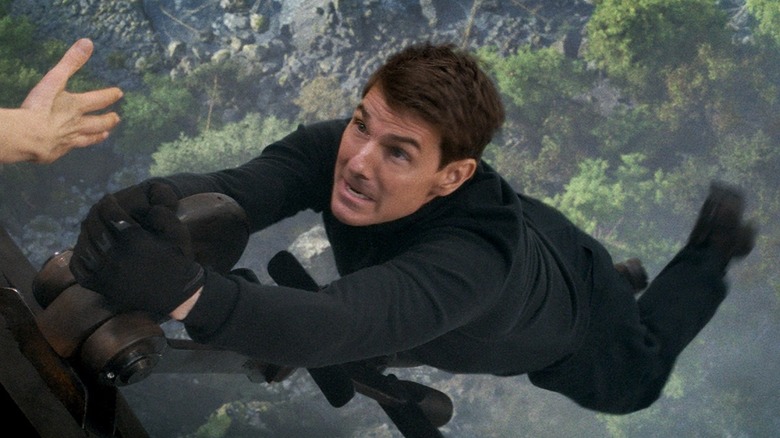Mission: Impossible – Dead Reckoning's Best Action Scene Has A Lot In Common With A Certain Jurassic Park Movie
This article contains spoilers for "Mission: Impossible — Dead Reckoning Part One."
Despite all the labyrinthine plotting, a revolving door of supporting cast members, and many "gotcha!" moments where both the characters and the audience get fooled, the biggest draw of the "Mission: Impossible" franchise has become its bravura action sequences. Of course, that's thanks in no small part to producer and star Tom Cruise's determination to put himself in harm's way while on camera in as dramatic a fashion as possible.
Yet these stunt sequences aren't just showcases for the various stuntpeople's skills and Cruise's prowess — because they're often done practically, there's a large amount of suspense involved in these scenes. Whereas other action franchises, like "John Wick" for example, are focused more on the choreography, gags, and the like, "Mission: Impossible" keeps its action sequences filled with suspense, both within the story itself (there are usually some world-ending stakes involved) and metafictionally.
Although Cruise's BASE jump from a cliff is the most marketed and talked-about stunt from "Dead Reckoning" so far, it's not the last stunt sequence in the film. That honor goes to the spectacular train crash that closes "Part One," only it's not any run-of-the-mill train crash. Director Christopher McQuarrie has the train crash over an extended period of time, milking the event for all the suspense possible. The nail-biting sequence is also highly reminiscent of one directed by another master of action-suspense: the T-Rex trailer attack, as seen in Steven Spielberg's "The Lost World: Jurassic Park."
Spielberg gives 'The Lost World' a literal cliffhanger
If "Jurassic Park" is about the hubris involved in playing God for purposes of capitalistic entertainment, "The Lost World" is a parable about the arrogance of humanity in attempting to control nature for either nefarious or noble purposes.
Spielberg and screenwriter David Koepp, adapting Michael Crichton's sequel novel, demonstrate that latter point in the movie's centerpiece sequence: activist Nick Van Owen (Vince Vaughn), along with paleontologist Sarah Harding (Julianne Moore) free a cadre of dinosaurs from the clutches of the InGen corporation, and in the process rescue an injured infant Tyrannosaurus Rex. Upon bringing the baby Rex back to their trailer camp, the child's cries attract its mother and father as Nick and Sarah attend to the kid's broken leg. Although Sarah, Nick, and Ian Malcolm (Jeff Goldblum) give the infant back to its parents, it's too late — the dinos attack the trailer in retribution.
In attempting to top the iconic moment of the T-Rex escaping her pen in the first "Jurassic Park," Spielberg milks every possible ounce of tension from the scene, stacking the deck against our helpless human heroes with each passing second: not only are there multiple Rexes instead of one, but the humans are soon trapped inside the trailer as the dinosaurs push it over a seaside cliff, causing Sarah to fall against what was once a front window and try to save herself before it cracks open.
Fortunately, the group's field equipment expert and pal Eddie Carr (Richard Schiff) manages to tow the trailer back up the cliff long enough for his friends to save themselves. Because this is "Jurassic Park," everything has a consequence and a cost — Eddie is turned into a wishbone by the Rexes, and the entire trailer falls down around Malcolm and the others while they hang onto a tow cable for dear life.
McQuarrie's 'giant train set' crashes in slow motion
In true "Mission: Impossible" fashion, McQuarrie wasn't going to be satisfied by staging the majority of the climactic sequence of "Dead Reckoning" in post. Instead, he saw the sequence as one involving "basically a giant train set," as he explained in the film's official press kit.
That ethos involves not just the way the scene was made, with a real-life train built to be destroyed, but the way it was designed, too: in the film, the train doesn't merely go careening off a bridge after the structure is blown apart by the terrorist Gabriel (Esai Morales). Instead, Ethan Hunt (Cruise) and his newly minted IMF compatriot, Grace (Hayley Atwell), are able to decouple the front of the train so that the rest of the cars slow down, but not enough so that momentum and gravity keep multiple train cars from slowly but surely sliding over the broken bridge while the two spies are stuck inside.
The sequence thrills in much the same way Spielberg's "Lost World" set piece does, by revealing new complications to the characters and the audience moment by moment. As Ethan and Grace first experience moments of zero gravity as the train decouples from the ground before toppling over, then have to hang on and climb their way out of train car after train car as each successive one falls away, the scene recalls not just the suspense of "The Lost World" but the upside-down environments of "Inception" and "Royal Wedding" as well as the "fight your way through different train car environments" of films like "Snowpiercer" and "Bullet Train."
Ultimately, the scene isn't just a spectacular climax for "Dead Reckoning Part One," but perfectly encapsulates the appeal of the "Mission: Impossible" franchise. It both recalls some of the best that cinema has had to offer over the decades while building upon it, going one further, accomplishing what some might say is the impossible.


